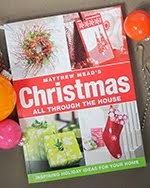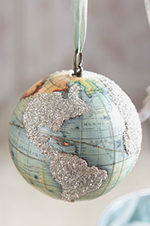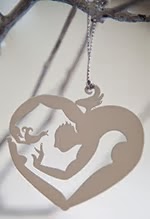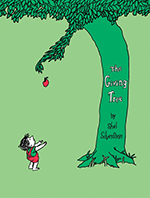A COUPLE OF EASTER Sundays in my childhood, my parents surprised me with an actual real-life Peter Cottontail instead of a chocolate bunny. We kept the bunny in a specially-constructed pen in our back yard. Even though I quickly figured out my bunny was never going to lay an egg, I always hoped it would happen. Magical things are happening all around in spring, so why not a bit of magical thinking? Much to my disappointment, the only thing that ever popped out of the bunnies were those little brown pellets that looked like cat kibble—not quite a wish come true.
 BUNNIES AND EGGS | (Both photos above) These roundly-formed glazed porcelain bunny ornaments from Pier 1 Imports were re-tied with a pale-striped yellow ribbon to match the yellow and white of the dogwood flower. Brown eggs were simply wrapped with Flake Cotton yarn (made in Brazil) from Ironstone and placed in an egg-shaped deviled egg platter.
BUNNIES AND EGGS | (Both photos above) These roundly-formed glazed porcelain bunny ornaments from Pier 1 Imports were re-tied with a pale-striped yellow ribbon to match the yellow and white of the dogwood flower. Brown eggs were simply wrapped with Flake Cotton yarn (made in Brazil) from Ironstone and placed in an egg-shaped deviled egg platter.
THE DOGWOOD flower became another symbol for spring, as explained in Sunday school at the local Baptist church where we attended—as a manifestation of the crucifixion of Jesus. I studied those flowers with their stigmata petals scared at each end and forming a cross radiating from a golden “crown of thorns” in the middle and it seemed like a plausible explanation that the cross Jesus was crucified on was made of a Dogwood tree and this is how they appeared thereafter. But there was never an explanation for why my bunny wasn't laying eggs! The reasons for both might be from man-made sources that are less than reliable than an explanation taken directly from Mother Nature's lessons. In myth and religion, things have been cross-pollinated so much that the result is a hybrid of ideas that have something for everyone to latch onto. The short answer is bunnies and eggs are closely associated because they are both symbols of fertility, new life and rebirth/renewal.
| EGGS AND FLOWERS | Nestled amongst sunny daffodil flowers and leaves, these lettered eggs from Pottery Barn spell out a Happy Easter greeting. |
NATURAL LIFE CYCLES in the spring
are the focus of any spring celebration. What has become today's Easter Bunny
is actually a surviving remnant of Pagan traditions celebrated in pre-Christian
days, and still practiced today by surviving Pagans and Christians alike, but
with different source meanings. In the Pagan view, Bunnies, rabbits and hares
are fertility symbols, sacred to the Goddess of the Dawn, once known as Ostarra
or Eostara, which is the origin of the word Easter. Due to the the well-known
procreational ability of rabbits, they are a perfect symbol for fertility.
Another more direct symbol for fertility is the egg for obvious reasons. Spring Equinox celebrations—both past and present—focus on
Spring growth. All the newly reborn flora and fauna, including the
ever-producing rabbit, are a sure sign the Spring season has begun and nature
continues its yearly cycle.
WHEN CHRISTIANITY first began to spread, there was an artful overlapping of Christian values and ideas with much loved Pagan customs, which attracted people to the church and pulled them away from their ways of honoring and living within nature. The Easter Bunny and egg hunts of the Old World were carried over to modern day celebrations. In the beginning, they had nothing to do with the Christian faith or belief in Jesus' resurrection. Because the Christian church celebrates the Resurrection of Christ in the spring, it made perfect sense to "borrow" from Pagan Spring rites in order to make the attraction to the newer religion plausible.
 |
| EGGS AND A CHICK | This tough chick with a cracked shell around its feet is laying claim to her future eggs. German paper mache candy containers borrow the perfect shape of an egg as an elegant container in which to give Easter treats. These modern versions are made by the German company Nestler. |
THE POPULARIZED candy form of the Easter Bunny probably emerged around the 1800’s when manufacturers in Germany created bunnies from bread and candy. German children were taught about Osterhase, an Easter bunny that hid eggs and chocolates carried in a woven basket backpack for children to find on Easter Sunday. Easter eggs became a commonplace way to exchange gifts in Springtime. Easter treats were concealed in paper mache candy containers. Those made in an original mold, by some of the same German family workshops that began their businesses more than 100 years ago have become highly collectible. Modern versions such as the ones in the photo above are an elegant way to present Easter gifts and treats.

NO NONSENSE EGGS | Unadorned, but decorative natural wooden eggs are nestled within a blooming Japanese magnolia branch and a ceramic egg crate.
THE TRADITION of the egg tree (see The Decorated Tree version here) was also popularized in Germany. The eggs used in cooking Easter meals in Germany (and elsewhere) are not broken, but are emptied by blowing the contents out into a container, through pinholes at either end of the egg. The hollowed eggshells are then decorated and dyed and hung from trees during spring.
NO MATTER how or why you celebrate springtime, there is no doubt that this is a season of rebirth. Flowering trees and flowers rise from dormancy and show their prettiest spring colors, much like church-goers do in their Easter Sunday best. Nature and faith are in a constant cycle of renewal and both are reaffirmed simultaneously in a sweet melding of ideas and beliefs. It's definitely a time to take a deep breath of life.
©2012 DARRYL MOLAND | ALL RIGHTS RESERVED
collecting, photography and styling by Darryl Moland






































No comments:
Post a Comment